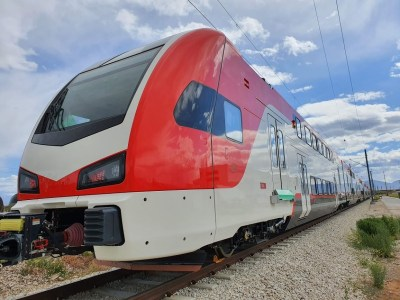F-Line to Dudley
Senior Member
- Joined
- Nov 2, 2010
- Messages
- 9,559
- Reaction score
- 10,453
https://www.masstransitmag.com/rail...ete-electric-multiple-unit-trainset-assembled

The bugfark high-and-low door scheme damn near killed 'em with design dead-ends on at least 3 different occasions and they will remain a cromulent cautionary tale on DO NOT OVER-MOD A DESIGN, but Caltrain's first complete EMU set has finally been assembled for testing. It's a shame they couldn't keep their grubby incompetent hands off the carbodies because of their cognitive dissonance on door heights, because otherwise the Stadler KISS make would've become the shoo-in reference case for breaking wide open the market for successful wholesale import of a proven Euro lightweight to American soil free from FRA cruft since Caltrain got granted with all the right waivers to do a properly clean straight import. But alas, Caltrain couldn't stop Caltrain'ing itself both hands around necks, so the resulting product is an overbudget half-unicorn that'll be a hard sell anywhere else. Primarily because one-time capital expenses to raise platform heights is less expensive than every-time vehicle-side solutions, and such truths rate as "DUH!"-obvious to everyone on Planet Earth except for the geniuses running the Peninsula Corridor Joint Powers Board straight into the ground.
Stadler did bid the Caltrain KISS-derived design sans low-level doors for the T's EMU RFI, but because it's still carrying the majority of the Caltrain mod cruft its chances are average-at-best for this procurement even without the dual-boarding door insanity. There had to be lots of carbody mods to fit in both, with Stadler importing the Euro low-boarding version and modding it for high-floor vestibules rather than the other way around because that was the easier template for Caltrain's requirements. High-boarding Euro KISS'es run primarily in Eastern Europe on Russian broad gauge track, while standard-gauge Germany and Switzerland run shitloads of 'em...but only the low-boarding version. So as an import prospect the broad gauge high-level version was a mod too far quick bidding vs. the Caltrain half-unicorn that's already blessed with all the right FRA waivering...therefore that's what Stadler went with in the T's RFI. That forces it into somewhat square-peg supply chaining for lifetime maint, and makes us uncomfortably dependent on Caltrain not self-pwning itself on the rollout in order to net the manufacturing scale for a good price point. So, in no small part to Caltrain doing the "Hold my beer..." on ill-advised modding, we take on a little elevated risk in Stadler's RFI presentation. Probably ends up blunting its chances just a bit. Whereas all of the low-boarding U.S. agencies considering future electrification or all-new service starts (diesel Metra/Chicagoland, Texas, Florida, Pac Northwest, Canada, etc.) would have a shoo-in choice picking the total unmodded Swiss/German low-board KISS straight off the global supply chain. Unfortunately East Coast platfom fittings don't today have quite as shoo-in an import template from Stadler, and have to rely on a *very* wobbly guinea pig in Caltrain for the proof-of-concept.

The bugfark high-and-low door scheme damn near killed 'em with design dead-ends on at least 3 different occasions and they will remain a cromulent cautionary tale on DO NOT OVER-MOD A DESIGN, but Caltrain's first complete EMU set has finally been assembled for testing. It's a shame they couldn't keep their grubby incompetent hands off the carbodies because of their cognitive dissonance on door heights, because otherwise the Stadler KISS make would've become the shoo-in reference case for breaking wide open the market for successful wholesale import of a proven Euro lightweight to American soil free from FRA cruft since Caltrain got granted with all the right waivers to do a properly clean straight import. But alas, Caltrain couldn't stop Caltrain'ing itself both hands around necks, so the resulting product is an overbudget half-unicorn that'll be a hard sell anywhere else. Primarily because one-time capital expenses to raise platform heights is less expensive than every-time vehicle-side solutions, and such truths rate as "DUH!"-obvious to everyone on Planet Earth except for the geniuses running the Peninsula Corridor Joint Powers Board straight into the ground.
Stadler did bid the Caltrain KISS-derived design sans low-level doors for the T's EMU RFI, but because it's still carrying the majority of the Caltrain mod cruft its chances are average-at-best for this procurement even without the dual-boarding door insanity. There had to be lots of carbody mods to fit in both, with Stadler importing the Euro low-boarding version and modding it for high-floor vestibules rather than the other way around because that was the easier template for Caltrain's requirements. High-boarding Euro KISS'es run primarily in Eastern Europe on Russian broad gauge track, while standard-gauge Germany and Switzerland run shitloads of 'em...but only the low-boarding version. So as an import prospect the broad gauge high-level version was a mod too far quick bidding vs. the Caltrain half-unicorn that's already blessed with all the right FRA waivering...therefore that's what Stadler went with in the T's RFI. That forces it into somewhat square-peg supply chaining for lifetime maint, and makes us uncomfortably dependent on Caltrain not self-pwning itself on the rollout in order to net the manufacturing scale for a good price point. So, in no small part to Caltrain doing the "Hold my beer..." on ill-advised modding, we take on a little elevated risk in Stadler's RFI presentation. Probably ends up blunting its chances just a bit. Whereas all of the low-boarding U.S. agencies considering future electrification or all-new service starts (diesel Metra/Chicagoland, Texas, Florida, Pac Northwest, Canada, etc.) would have a shoo-in choice picking the total unmodded Swiss/German low-board KISS straight off the global supply chain. Unfortunately East Coast platfom fittings don't today have quite as shoo-in an import template from Stadler, and have to rely on a *very* wobbly guinea pig in Caltrain for the proof-of-concept.

%2C_July_2020.JPG/800px-Venture_test_train_at_Oakland_Maintenance_Facility_(2)%2C_July_2020.JPG)
%2C_July_2020.JPG/800px-Venture_test_train_at_Oakland_Maintenance_Facility_(4)%2C_July_2020.JPG)


